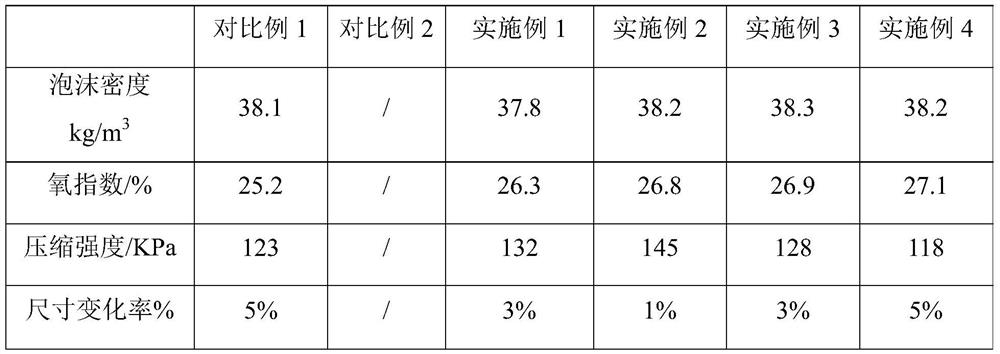Pentane type multi-component high-flame-retardant polyurethane composite phenolic aldehyde continuous plate composite material and preparation method thereof
A phenolic continuous plate, multi-component technology, applied in the field of polyurethane composite modification, can solve the problems of unsatisfactory physical properties, difficulty in practical promotion, high cost, easy large-scale industrial production, simple and convenient preparation method, and solve the problem of brittleness Effect
- Summary
- Abstract
- Description
- Claims
- Application Information
AI Technical Summary
Problems solved by technology
Method used
Image
Examples
Embodiment 1
[0042] Step 1. Preparation of component A: 40 parts of 4110 polyether polyol, 30 parts of phthalic anhydride polyester, 30 parts of phenolic resin, 2 parts of hard foam silicone oil foam stabilizer, 1.0 parts of water, 30 parts of flame retardant, 2 parts The tertiary amine amine catalyst is stirred evenly according to the proportion, and the A component is obtained.
[0043] Step 2. Preparation of component B: Mix 3 parts of potassium acetate catalyst, 3 parts of formic acid curing agent, 3 parts of ethylene glycol, etc. according to the proportion and stir evenly to obtain component B.
[0044] Step 3: Take 15 parts of cyclopentane as component C; take 251 parts of isocyanate (PM200 from Wanhua) as component D.
[0045] Step 4: Mix A component, B component, C component, and D component according to the mass ratio of 135:3:15:251, pour it into a square mold of 30cm*30cm*10cm for reaction, and obtain sample block 3 .
Embodiment 2
[0047] Step 1. Preparation of component A: 40 parts of 4110 polyether polyol, 20 parts of phthalic anhydride polyester, 40 parts of phenolic resin, 2 parts of hard foam silicone oil foam stabilizer, 1.0 parts of water, 30 parts of flame retardant, 2 parts The tertiary amine amine catalyst is stirred evenly according to the proportion, and the A component is obtained.
[0048] Step 2. Preparation of component B: Mix 3 parts of potassium acetate catalyst, 4 parts of formic acid curing agent, 3 parts of ethylene glycol, etc. according to the proportion and stir evenly to obtain component B.
[0049] Step 3: Take 15 parts of cyclopentane as component C; take 251 parts of isocyanate (PM200 from Wanhua) as component D.
[0050] Step 4: Mix A component, B component, C component, and D component according to the mass ratio of 135:3:15:251, pour it into a square mold of 30cm*30cm*10cm for reaction, and obtain sample 4 .
Embodiment 3
[0052] Step 1. Preparation of component A: 40 parts of 4110 polyether polyol, 10 parts of phthalic anhydride polyester, 50 parts of phenolic resin, 2 parts of hard foam silicone oil foam stabilizer, 1.0 parts of water, 30 parts of flame retardant, 2 parts The tertiary amine amine catalyst is stirred evenly according to the proportion, and the A component is obtained.
[0053] Step 2. Preparation of component B: Mix 3 parts of potassium acetate catalyst, 5 parts of formic acid curing agent, 3 parts of ethylene glycol, etc. according to the proportion and stir evenly to obtain component B.
[0054] Step 3: Take 15 parts of cyclopentane as component C; take 251 parts of isocyanate (PM200 from Wanhua) as component D.
[0055] Step 4. Mix components A, B, C and D according to the mass ratio of 135:3:15:251, and pour them into a square mold of 30cm*30cm*10cm for reaction to obtain a sample block 5.
PUM
| Property | Measurement | Unit |
|---|---|---|
| hydroxyl value | aaaaa | aaaaa |
| hydroxyl value | aaaaa | aaaaa |
| Functional group degree | aaaaa | aaaaa |
Abstract
Description
Claims
Application Information
 Login to View More
Login to View More - R&D
- Intellectual Property
- Life Sciences
- Materials
- Tech Scout
- Unparalleled Data Quality
- Higher Quality Content
- 60% Fewer Hallucinations
Browse by: Latest US Patents, China's latest patents, Technical Efficacy Thesaurus, Application Domain, Technology Topic, Popular Technical Reports.
© 2025 PatSnap. All rights reserved.Legal|Privacy policy|Modern Slavery Act Transparency Statement|Sitemap|About US| Contact US: help@patsnap.com

